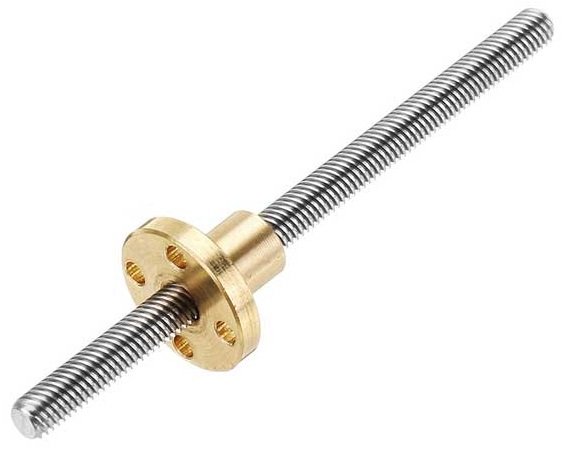The conversion of different types of mechanical movements has always been one of the main challenges of engineers. Thanks to various mechanisms, this has led to advances in industry and the design and construction of various machines. One of these mechanisms is the conversion of rotary motion to linear motion or vice versa, which some engineers believe was first used by workers in ancient Egypt. But what is a lead screw? A lead screw, also known as a power screw or transition screw, is a mechanical product and one of the main mechanisms for converting rotary motion into linear motion. Lead screws have a wide range of applications in the industry.
Lead screws are generally made up of a threaded screw and a nut. Although they may seem straightforward at first glance, the various applications of these parts have turned them into mechanically sensitive pieces. In the following image, you can see a type of lead screw and its nut.

Different types of lead screws
Lead screws are classified based on their material and the type of threads used in them:

Lead Screw Material:
The material of these products depends on their application. The shaft of lead screws is usually made of steel, stainless steel, or aluminum. Steel shafts are often used in lathes and CNC machines subjected to higher tension. Aluminum shafts are sometimes used in 3D printers and small CNC machines because lead screws in these machines are not subjected to high pressure, and the lightweight nature of aluminum improves the performance of the machine.
The material used in the nuts of lead screws is also very important. These nuts are made of brass, aluminum, iron, bronze, and even plastic. The use of brass and aluminum in the nuts prevents the lead screw shaft from rusting and is readily available and easy to produce. The low coefficient of friction, strength, and corrosion resistance are the advantages of using bronze alloy in lead screw nuts. However, it should be noted that the cost of using bronze alloy is much higher than other metals such as aluminum and brass, which has led to less use in the industry. Plastic is another material used in lead screw nuts to reduce noise during operation, lightweight, and resistant, in lightweight machines. One of the main disadvantages of using plastic nuts in lead screws is their insufficient strength and significant deformation.
Lead Screw Threads:
Lead screws are manufactured in different types of thread: Square, trapezoidal, and Acme
Square lead screws: Square lead screws, due to their geometric design, can transmit more power compared to others and perform similarly well in both directions. However, they also have some disadvantages, the most important of which is the complexity of their production process, leading to a higher price compared to other types.
Trapezoidal: In lead screws with trapezoidal threads, due to the geometric shape of the trapezoid and its two inclined sides, friction and wear between the shaft and nut are reduced, significantly aiding in the performance and increasing the speed of motion transfer.
Acme: Acme thread is one of the common and standard types of threads used in lead screws. These threads have conical angles with the smallest pitch and greater depth, which improves load transfer between the screw and nut and makes the rotation process smoother. In the Acme type, motion transfer occurs only in one direction. Despite the simplicity of the production method of this type of lead screw compared to others, they have a more limited application due to the limitation in the direction of motion transfer.

Applications of lead screws
CNC Machine and 3D Printer:
One of the most fundamental components used in CNC machines and 3D printers is the lead screw (or ball screw) and nut. Without them, there would be no linear motion, and directing the spindle and manufacturing the part would not be possible. The lead screw in a machine is connected to stepper motors controlled by an electronic system. By rotating these motors, the lead screws convert this rotation into linear motion. Lead screws act as X-axis, Y-axis, and Z-axis, and facilitate the creating of the desired parts. In 3d printers, mostly, lead screws control the extruder under the control of an electronic unit and guide it using stepper motors to produce the part.

Lathe Machine:
Lead screws are one of the most important components of a lathe machine, responsible for guiding the carriage and cross-slide component in a straight line and in two directions. The lead screw and nut used in the lathe machine are made of steel to withstand heavy loads and maintain over time.




